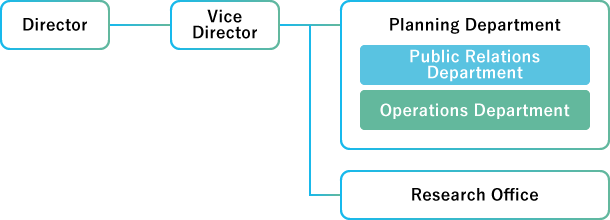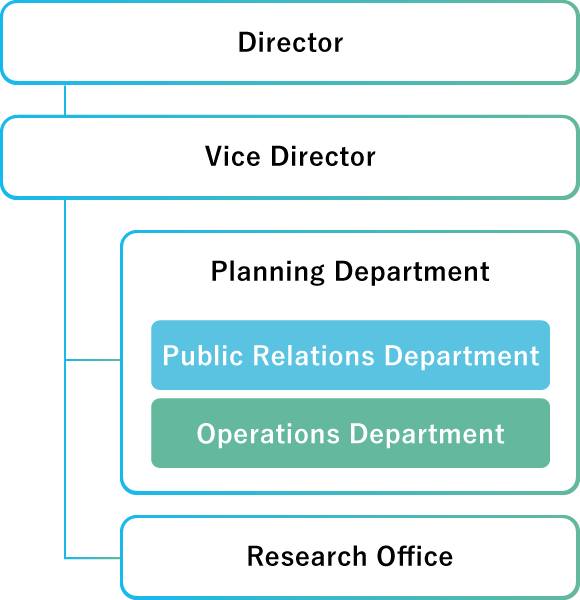“Passing on to future generations and sharing with the world”
records and lessons from the nuclear disaster and the recovery process.
The Great East Japan Earthquake and Nuclear Disaster Memorial Museum is a prefectural facility in Futaba Town, Fukushima Prefecture which opened on September 20, 2020. In addition to the exhibition showing the reality of the unprecedented triple disaster in Fukushima caused by the earthquake, tsunami, and TEPCO’s Fukushima Daiichi Nuclear Power Plant accident as well as the progress to reconstruction, storytelling lectures are given four times a day by residents who experienced the disaster first hand.
Aside from exhibition tours, lessons for disaster prevention and mitigation are disseminated both domestically and internationally for the future through training programs, surveys, and research.
The Great East Japan Earthquake struck at 2:46 p.m. on March 11, 2011.
The 2011 off the Pacific coast of Tohoku Earthquake with moment magnitude of 9.0 struck the entire region of Eastern Japan, which had a maximum seismic intensity of 7(6+ in Fukushima Prefecture), one of the most powerful earthquakes on record in Japan. And in the tsunami that followed, more than 18,000 people have been reported dead or missing nationwide.
Due to the nuclear disaster caused by the accident at TEPCO’s Fukushima Daiichi Nuclear Power Plant, tens of thousands of people are still forced to live away from their hometowns with no end in sight to the decommissioning of the damaged Nuclear Power Plant and measures to tackle reputational damage from harmful rumors.
In Fukushima Prefecture alone, more than 4,000 people lost their lives. This figure includes 2,000+ people who have died as an indirect result of the disaster after experiencing poor health or overwork as they struggled with their lives as evacuees, illustrating the severity of the triple disaster and how the impact is still being felt today.
[Reference]
National Police Agency Website|About the Great East Japan Earthquake
Reconstruction Agency|Number of disaster-related deaths
Fukushima Prefecture Website|10 Years of Records of the Great East Japan Earthquake and Nuclear Disaster
It is the common desire of the people who experienced it themselves that the lessons and records from this massive and compound disaster never faced by the world before,
and the history of the steady recovery process that followed, are gathered, preserved and investigated, so that they can be passed on to following generations and shared with the world without fading away.
The Great East Japan Earthquake and Nuclear Disaster Memorial Museum clearly communicates and reveals the nuclear power disaster that only Fukushima has experienced,
and is built on the following three basic principles.
records and lessons from the nuclear disaster and the recovery process.
based on the experiences and lessons from the nuclear disaster that only Fukushima has encountered.
by uniting with people and organizations who want to help Fukushima and working to revive communities and local traditions as well as train people to take part in the regions recovery.

I am Noboru Takamura, from Nagasaki University.
On April 1, 2020 I was appointed as the Director of The Great East Japan Earthquake and Nuclear Disaster Memorial Museum.
Directly after the accident at TEPCO’s Fukushima Daiichi Nuclear Power Station, I went to Fukushima Prefecture and explained to its people about radiation exposure and its health effects from a scientific perspective. I also become involved in supporting the recovery of the town of Tomioka, and the adjoining village of Kawauchimura, whose people were evacuated due to the accident but afterwards quickly began to return.
It is now nearly ten years since the accident at the power station in 2011. In this time, Fukushima Prefecture has directly faced the extremely challenging mission of rebuilding itself after earthquake, tsunami, and nuclear disaster.
The Memorial Museum, which was opened in September 2020, aims to collect, store, and display as archives the evidence of Fukushima’s struggle toward recovery. We hope the museum can act as a base where knowledge can be shared – a place where people from both within and outside Japan can learn about a vast range of knowledge that has been gained from Fukushima’s past and will continue to be gained in its future. I also hope that the museum can play an active part in the Fukushima Innovation Coast Framework.
Together with my staff, I am looking forward to meeting our many visitors.
The Great East Japan Earthquake and Nuclear Disaster Memorial Museum Director Noboru Takamura


There are always staff on hand in the exhibition area. So please feel free to ask them questions about the exhibits.
| Founder | Fukushima Prefecture |
|---|---|
| Management and operation | Fukushima Innovation Coast Promotion Organization was appointed as the designated administrator by Fukushima Prefecture and manages and operates the facility. |
| Overview | Exhibition Facility |
| Location | 39 Takada, Nakano, Futaba Town, Futaba-gun |
| Total Floor Area | Total floor area 5,256㎡(1F:約2,675㎡、2F:2,358㎡、3F:195㎡) |
| Structure and Size | Three floor, reinforced concrete structure (with a steel frame in one section) |
| Capacity of Parking Lot | Buses: 10, Cars: 111 |
| Main Features | Prologue Theatre, Exhibition Area (permanent and temporary exhibits), Workshop Room, Training Room (120 person capacity), Document Viewing Room etc. |
| March 31, 2015 | During an interim summary of the Innovation Coast Framework Case Review Commission, the government ordered the establishment of a research association to examine the creation of an archive base in Fukushima Prefecture. |
|---|---|
| April – August 2015 | A series of expert meetings were held in Fukushima to discuss the establishment of the archive base for the Great East Japan Earthquake and the nuclear disaster. The necessity of the facility was examined across five meetings. |
| September 2015 | At a conference of experts, reports were organized and submitted to the governor of Fukushima. |
| June – December 2016 | The size, function and location of the archive was examined during four meetings regarding the establishment of the archive’s basic structure. |
| March 27, 2017 | The basic structure for the facility was decided upon at the New Fukushima Revitalization Promotion Headquarters Meeting held in Fukushima. The location, basic principles and the exhibition story were discussed. |
| April 25, 2018 | The facility was approved to be included in the Intensive Promotion Plans based on the Act on Special Measures for the Reconstruction and Revitalization of Fukushima. (It was stated that managing the facility through the Fukushima Innovation Coast Framework based on a set management system would be examined). |
| September 20, 2020 | The Great East Japan Earthquake and Nuclear Disaster Memorial Museum was opened. |